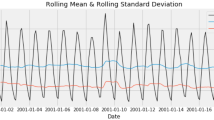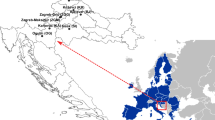Abstract
Since ionospheric variability changes dramatically before the major earthquakes (EQ), the detection of ionospheric anomalies for EQ forecasting has been a hot topic for modern-day researchers for the last couple of decades. Therefore, there is a need to identify highly accurate, advance, and intelligent models to identify these anomalies. In the present study, we have discussed artificial intelligence techniques e.g. autoregressive integrated moving average (ARIMA), and long short-term memory (LSTM) network, to detect ionospheric anomalies using the total electron content (TEC) time series over the epicenter of Mw 7.0 Haiti EQ on January 12, 2010. We have considered 20 days of TEC data with a daily 2-h interval and trained the models with an accuracy of 1.28 and 0.07 TECU for ARIMA and LSTM, respectively. Both ARIMA and LSTM results showed that the negative anomalies are recorded 5 days before the EQ (January 7), while strong positive anomalies are recorded 1–2 days before the EQ (January 11–12) that are consistent with the findings of previous studies. Moreover, the quiet space weather conditions during the analyzed period indicate that the observed variations could be considered precursors to the impending Haiti EQ. Our analysis suggests that the performance of the LSTM model is more robust as compared to the ARIMA model in terms of detection of seismoionospheric anomalies.











Similar content being viewed by others
Data availability
The authors are thankful to the IGS network for providing the GIMs, the United States Geological Survey (USGS) for providing information about the EQ, and OmniWeb NASA for providing the space-weather indices.
Code availability
The computer code, written in Python.3, debugged on Jupyter Notebook which can be downloaded from the link: https://jupyter.org/. Jupyter Notebook is a nonprofit organization created to “develop open-source software, open standards, and services for interactive computing across dozens of programming languages”. The code can be accessed from the public GitHub repository: https://github.com/Saqib9828/computers-and-geosciences/tree/master/ARIMA_LSTM_HAITI.
References
Adil MA, Abbas A, Ehsan M, Shah M, Naqvi NA, Alie A (2021a) Investigation of ionospheric and atmospheric anomalies associated with three Mw >6.5 EQs in New Zealand. J Geodyn 145:101841
Adil MA, Şentürk E, Pulinets SA, Amory-Mazaudier C (2021b) A lithosphere–atmosphere–ionosphere coupling phenomenon observed before M 7.7 jamaica earthquake. Pure Appl Geophys 178:3869–3886
Adil MA, Şentürk E, Shah M, Naqvi NA, Saqib M, Abbasi AR (2021c) Atmospheric and ionospheric disturbances associated with the M> 6 earthquakes in the East Asian sector: a case study of two consecutive earthquakes in Taiwan. J Asian Earth Sci 220:104918
Akhoondzadeh M (2012) Anomalous TEC variations associated with the powerful Tohoku earthquake of 11 March 2011. Nat Hazard 12(5):1453
Akhoondzadeh M (2013a) A genetic algorithm for TEC seismo-ionospheric anomalies detection around the time of the Solomon (Mw= 8.0) earthquake of 06 February 2013. Adv Space Res 52(4):581–590
Akhoondzadeh M (2013b) An MLP neural network as an investigator of the TEC time series to detect seismo-ionospheric anomalies. Adv Space Res 51(11):2048–2057
Akhoondzadeh M (2013c) Support vector machines for TEC seismo-ionospheric anomalies detection. Ann Geophys 31(2):173–186
Akhoondzadeh M (2014) Investigation of GPS-TEC measurements using the ANN method indicating seismo-ionospheric anomalies around the time of the Chile (Mw= 8.2) earthquake of 01 April 2014. Adv Space Res 54(9):1768–1772
Akhoondzadeh M, Saradjian MR (2011) TEC variations analysis concerning Haiti (January 12, 2010) and Samoa (September 29, 2009) earthquakes. Adv Space Res 47(1):94–104
Astafyeva E (2019) Ionospheric detection of natural hazards. Rev Geophys 57:1265–1288
Bartholomew DJ (2020) Time series analysis forecasting. Oper Res Q 22(2):199–201
Buonsanto M (1999) Ionospheric storms—a review. Space Sci Rev 88:563–601
Cranmer SR (2002) Coronal holes and the high-speed solar wind. Space Sci Rev 101(3–4):229–294
Davies K, Baker DM (1965) Ionospheric effects were observed around the time of the Alaskan earthquake of March 28, 1964. J Geophys Res 70(9):2251–2253
Elias AG (2014) Filtering ionosphere parameters to detect trends linked to anthropogenic effects. Earth Planets Space 66(1):113
Freeshah M, Zhang X, Şentürk E, Adil MA, Mousa BG, Tariq A, Ren X, Refaat M (2021a) Analysis of atmospheric and ionospheric variations due to impacts of Super Typhoon Mangkhut (1822) in the Northwest Pacific Ocean. Remote Sens 13(4):661
Freeshah M, Zhang X, Şentürk E, Ren X, Adil MA, Xu G (2021b) Could the Beirut explosion perturb the Ionosphere? Pre-results using TEC-GNSS observations., EGU General Assembly 2021, online, 19–30 Apr 2021, EGU21-8990
Fuller WA (2009) Introduction to statistical time series, vol 428. Wiley, New York
Fuying Z, Yun W, Ningbo F (2011) Application of Kalman filter in detecting pre-earthquake ionospheric TEC anomaly. Geodesy Geodyn 2(2):43–47
Gulli A, Pal S (2017) Deep learning with Keras. Packt Publishing Ltd., Birmingham
Iban MC, Şentürk E (2021) Machine learning regression models for prediction of multiple ionospheric parameters. Adv Space Res. https://doi.org/10.1016/j.asr.2021.11.026
Kaselimi M, Voulodimos A, Doulamis N, Doulamis A, Delikaraoglou D (2020) A causal long short-term memory sequence to sequence model for TEC prediction using GNSS observations. Remote Sens 12(9):1354
Kumar S, Singh A (2017) Ionospheric precursors observed in TEC due to earthquake of Tamenglong on 3 January 2016. Curr Sci 113(4):795–801
Kumar S, Tripathi G, Kumar P et al (2021) Ionospheric perturbations observed due to Indonesian Earthquake (Mw = 7.4) using GPS and VLF measurements at multi-stations. Acta Geod Geophys. https://doi.org/10.1007/s40328-021-00345-5
Le H, Liu L, Liu JY, Zhao B, Chen Y, Wan W (2013) The ionospheric anomalies prior to the M9.0 Tohoku-Oki earthquake. J Asian Earth Sci 62:476–484
Li ZG, Li WC, Cheng ZY, Feng CG (2008) Direct and indirect methods on predicting ionosphere and their compare. Acta Astron Sinica 49(1):29–44
Li W, Guo J, Yue J, Yang Y, Li Z, Lu D (2016) Contrastive research of ionospheric precursor anomalies between Calbuco volcanic eruption on April 23 and Nepal earthquake on April 25, 2015. Adv Space Res 57(10):2141–2153
Lin JW (2010) Two-dimensional ionospheric total electron content map (TEC) seismo-ionospheric anomalies through image processing using principal component analysis. Adv Space Res 45(11):1301–1310
Lin JW (2011) Is it possible to trace an impending earthquake’s occurrence from seismo-ionospheric disturbance using principal component analysis? A study of Japan’s Iwate-Miyagi Nairiku earthquake on 13 June 2008. Comput Geosci 37(7):855–860
Lin JW (2012) Ionospheric total electron content anomalies due to Typhoon Nakri on 29 May 2008: a nonlinear principal component analysis. Comput Geosci 46:189–195
Liu JY, Chen YI, Chuo YJ, Tsai HF (2001) Variations of ionospheric total electron content during the Chi-Chi earthquake. Geophys Res Lett 28(7):1383–1386
Liu JY, Chuo YJ, Shan SJ, Tsai YB, Chen YI, Pulinets SA, Yu SB (2004) Pre-earthquake ionospheric anomalies registered by continuous GPS TEC measurements. Ann Geophysicae 22(5):1585–1593
Liu JY, Chen YI, Chen CH, Liu CY, Chen CY, Nishihashi M, Li JZ, Xia YQ, Oyama KI, Hattori K, Lin CH (2009) Seismoionospheric GPS total electron content anomalies observed before the 12 May 2008 Mw7·9 Wenchuan earthquake. J Geophys Res Space Phys 114:A04320
Liu JY, Le H, Chen YI, Chen CH, Liu L, Wan W, Su YZ, Sun YY, Lin CH, Chen MQ (2011) Observations and simulations of seismoionospheric GPS total electron content anomalies before the 12 January 2010 M7 Haiti earthquake. J Geophys Res Space Phys 116:A04302
Namgaladze AA, Zolotov OV, Prokhorov BE (2013) Numerical simulation of the variations in the total electron content of the ionosphere observed before the Haiti earthquake of January 12, 2010. Geomag Aeron 53:522–528
Pancheva D, Mukhtarov P (2011) Stratospheric warmings: the atmosphere–ionosphere coupling paradigm. J Atmos Solar Terr Phys 73(13):1697–1702
Pedregosa F, Varoquaux G, Gramfort A, Michel V, Thirion B, Grisel O, Vanderplas J (2011) Scikit-learn: machine learning in Python. J Mach Learn Res 12:2825–2830
Pulinets SA (1998) Strong earthquake prediction possibility with the help of topside sounding from satellites. Adv Space Res 21(3):455–458
Pulinets S, Ouzounov D (2011) Lithosphere–Atmosphere–Ionosphere Coupling (LAIC) model—an unified concept for earthquake precursors validation. J Asian Earth Sci 41(4–5):371–382
Pulinets SA, Tsybulya KG (2010) Unique variations of the total electron content in the preparation period of Haitian earthquake (M7.9) on January 12, 2010. Geomag Aeron 50:686–689
Pulinets SA, Legen’Ka AD, Gaivoronskaya TV, Depuev VK (2003) Main phenomenological features of ionospheric precursors of strong earthquakes. J Atmos Solar-Terr Phys 65(16–18):1337–1347
Saqib M, Şentürk E, Sahu SA et al (2021) Ionospheric anomalies detection using autoregressive integrated moving average (ARIMA) model as an earthquake precursor. Acta Geophys 69:1493–1507
Sarkar S, Choudhary S, Sonakia A, Vishwakarma A, Gwal AK (2012) Ionospheric anomalies associated with the Haiti earthquake of 12 January 2010 observed by DEMETER satellite. Nat Hazard 12:671–678
Schaer S, Gurtner W, Feltens J (1998). IONEX: the ionosphere map exchange format version 1. In: Proceedings of the IGS AC workshop, Darmstadt, Germany (vol 9, no 11)
Singh RP, Mehdi W, Sharma M (2010) Complementary nature of surface and atmospheric parameters associated with Haiti earthquake of 12 January 2010. Nat Hazard 10:1299–1305
Shah M, Aibar AC, Tariq MA, Ahmed J, Ahmed A (2020) Possible ionosphere and atmosphere precursory analysis related to Mw> 6.0 earthquakes in Japan. Remote Sens Environ 239:111620
Srivani I, Prasad GSV, Ratnam DV (2019) A deep learning-based approach to forecast ionospheric delays for GPS signals. IEEE Geosci Remote Sens Lett 16(8):1180–1184
Sun W, Xu L, Huang X, Zhang W, Yuan T, Chen Z, Yan Y (2017) Forecasting of ionospheric vertical total electron content (TEC) using LSTM networks. In: 2017 International Conference on Machine Learning and Cybernetics (ICMLC) (vol 2, pp 340–344). IEEE
Sun W, Xu L, Huang X, Zhang W, Yuan T, Yan Y (2017) Bidirectional LSTM for ionospheric vertical Total Electron Content (TEC) forecasting. In: 2017 IEEE Visual Communications and Image Processing (VCIP) (pp 1–4). IEEE
Sunil AS, Bagiya MS, Reddy CD et al (2015) Post-seismic ionospheric response to the 11 April 2012 East Indian Ocean doublet earthquake. Earth Planets Space 67:37
Şentürk E, Livaoğlu H, Çepni MS (2019) A comprehensive analysis of ionospheric anomalies before the Mw 7.1 Van Earthquake on 23 October 2011. J Navig 72(3):702–720
Şentürk E, İnyurt S, Sertçelik İ (2020) Ionospheric anomalies associated with Mw7. 3 Iran-Iraq border earthquake and a moderate magnetic storm. Annales Geophysicae Discussions 1–19
Şentürk E, Adil MA, Saqib M (2021) Ionospheric total electron content response to annular solar eclipse on June 21, 2020. Adv Space Res 67(6):1937–1947
Tang R, Zeng F, Chen Z, Wang JS, Huang CM, Wu Z (2020) The comparison of predicting storm-time ionospheric TEC by Three methods: ARIMA, LSTM, and Seq2Seq. Atmosphere 11(4):316
Tariq MA, Shah M, Hernández-Pajares M, Iqbal T (2019) Pre-earthquake ionospheric anomalies before three major earthquakes by GPS-TEC and GIM-TEC data during 2015–2017. Adv Space Res 63(7):2088–2099
Wang S, Liu LL, Huang LK, Yang YZ, Peng H (2020) Performance evaluation of ionospheric TEC forecasting models using GPS observations at different latitudes. Int Arch Photogramm Remote Sens Spatial Inf Sci 42:1175–1182
Zhang GP (2003) Time series forecasting using a hybrid ARIMA and neural network model. Neurocomputing 50:159–175
Zhang X, Ren X, Wu F, Lu Q (2014) Short-term TEC prediction of ionosphere based on ARIMA model. Acta Geodaetica Cartogr Sin 2:118–124
Funding
The research is funded by DST (SERB) under MATRICS project MTR/2020/000287 titled “Earthquake Early Warning detection and classification based on TEC value using Artificial Intelligence.”
Author information
Authors and Affiliations
Contributions
The MS and SAS authors conducted the design of the study, programmed the ARIMA and LSTM models, and results with his intellectual knowledge. The ES and MAA authors acquired and analyzed ionospheric data, preprocessing, analyzed space weather indices. All authors gave their final approval of the manuscript version to be submitted the authors’ original work, hasn’t received prior publication, and isn’t under consideration for publication elsewhere.
Corresponding author
Ethics declarations
Conflict of interest
The authors declare no conflict of interest.
Rights and permissions
About this article
Cite this article
Saqib, M., Şentürk, E., Sahu, S.A. et al. Comparisons of autoregressive integrated moving average (ARIMA) and long short term memory (LSTM) network models for ionospheric anomalies detection: a study on Haiti (Mw = 7.0) earthquake. Acta Geod Geophys 57, 195–213 (2022). https://doi.org/10.1007/s40328-021-00371-3
Received:
Accepted:
Published:
Issue Date:
DOI: https://doi.org/10.1007/s40328-021-00371-3




